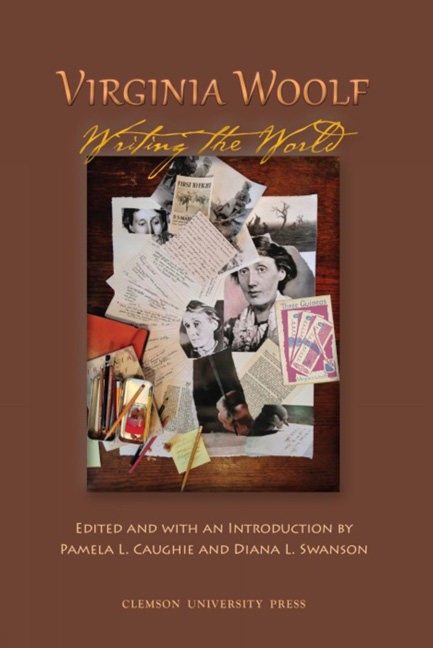Book contents
- Frontmatter
- Table of Contents
- Introduction
- Acknowledgmen
- Abbreviation
- WAR AND PEACE
- WORLD WRITER(S)
- Teaching Privileges: Three Guineas and the Cost of Global Citizenship
- From Guineas to Riyals: Teaching Woolf in the Middle East
- Fashionable Misconceptions: The Creation of the East in Virginia Woolf's Orlando
- From London to Taipei: Writing the Past in “Wandering in the Garden, Waking from a Dream” and Mrs. Dalloway
- An Estranged Intimacy with the World: The Postcolonial Woolf's Planetary Love in The Voyage Out
- “Shakespeare's Sister”: Woolf in the World Before A Room of One's Own
- Leonard Woolf: Writing the World of Palestine, Zionism, and the State of Israel
- ANIMAL AND NATURAL WORLD
- WRITING AND WORLDMAKING
- Notes on Contributors
- Conference Program
- Appendix: Virginia Woolf Conference Exhibit Items, Newberry Library
From London to Taipei: Writing the Past in “Wandering in the Garden, Waking from a Dream” and Mrs. Dalloway
from WORLD WRITER(S)
- Frontmatter
- Table of Contents
- Introduction
- Acknowledgmen
- Abbreviation
- WAR AND PEACE
- WORLD WRITER(S)
- Teaching Privileges: Three Guineas and the Cost of Global Citizenship
- From Guineas to Riyals: Teaching Woolf in the Middle East
- Fashionable Misconceptions: The Creation of the East in Virginia Woolf's Orlando
- From London to Taipei: Writing the Past in “Wandering in the Garden, Waking from a Dream” and Mrs. Dalloway
- An Estranged Intimacy with the World: The Postcolonial Woolf's Planetary Love in The Voyage Out
- “Shakespeare's Sister”: Woolf in the World Before A Room of One's Own
- Leonard Woolf: Writing the World of Palestine, Zionism, and the State of Israel
- ANIMAL AND NATURAL WORLD
- WRITING AND WORLDMAKING
- Notes on Contributors
- Conference Program
- Appendix: Virginia Woolf Conference Exhibit Items, Newberry Library
Summary
Hsien-yung Pai's “Wandering in the Garden, Waking from a Dream” (1968) is one of the most famous short stories in post-1949 Taiwanese literature. “Wandering” delineates a banquet among a group of “exiled” Mainland Chinese, many of whom are former female recitalists of K'un-ch’ü and whose social and economic status ascends through marriage. The work is famous for its stream-of-consciousness technique and its collage of references to traditional Chinese literature, as well as its representation of the very refined art of K'un-ch’ü opera, “an exclusive art for aristocratic connoisseurs” (“Wandering” 382). It is not surprising that Pai's writing is influenced by Western modernisms; after all, he graduated from the Department of Foreign Languages and Literatures at National Taiwan University before pursuing further studies in the United States. However, in a response to Sher-shiueh Li's question after a talk in 2003, Pai himself asserted Woolf ‘s partial influence on his “Wandering.” Li then published “Towards a Poetics of Parentheses,” which compares Mrs. Dalloway (1925) with “Wandering.” Li argues that the usage of parentheses by both authors reveals a deeper reality in characters’ minds (167–68).
Indeed, there are many similarities between Mrs. Dalloway and “Wandering.” Both stories focus on one main female character and her past love. The contrast between Bourton and London resembles that between China and Taipei; in both cases, memories of the past saturate the present-day settings. The opera lyrics she sings reflect Madame Ch'ien's own desire, evoking memories of her pre-war extra-marital love aff air in China. However, there appears to be a more profound link between the two works. Woolf's influence on Pai lies not merely in the parallel construction of the plots. Even stating that Pai's narrative technique is similar to that of Woolf seems to reduce the depth of the connection between the two works. Pai's “psychological realism” can be understood in phenomenological terms since it is a realism that aims to stay true not to the external reality but to the inner self. On the surface, such a realism seems to be achieved through symbols, internal monologues, and other literary techniques.
- Type
- Chapter
- Information
- Virginia Woolf: Writing the World , pp. 110 - 115Publisher: Liverpool University PressPrint publication year: 2015



